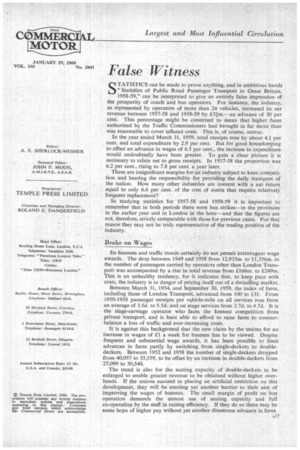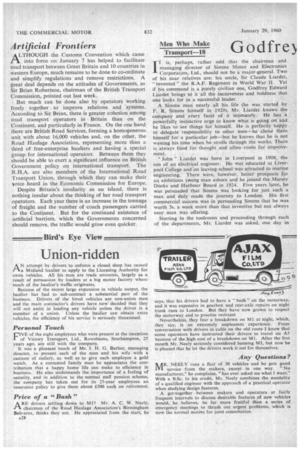False Witness
Page 29

Page 30

If you've noticed an error in this article please click here to report it so we can fix it.
STATISTICS can be made to prove anything, and in ambitious hands "Statistics of Public Road Passenger Transport in Great Britain, 1958-59," can be interpreted to give an entirely false impression of the prosperity of coach and bus operators. For instance, the industry, as represented by operators of more than 24 vehicles, increased its net revenue between 1957-58 and 1958-59 by £32m.—an advance of 30 per cent. This percentage might be construed to mean that higher fares authorized by the Traffic Commissioners had brought in far more than was reasonable to cover inflated.costs. • This is, of course, untrue. • In the year ended March 31, 1959, total receipts rose by about 4.1 per cent, and total expenditure by 2.9 per cent. But for good housekeeping to offset an advance in wages of 6.5 per cent., the increase in expenditure would undoubtedly have been greater. To gain a clear picture it is necessary to relate net to gross receipts. In 1957-58 the proportion was 6.2 per cent., rising to 7.8 per cent. a year later.
These are insignificant margins for an industry subject to keen competition and bearing the responsibility for providing the daily transport of the nation. How many other industries are content with a net return. equal to only 6.6 per cent. of the cost of assets that require relatively frequent replacement?
In studying statistics for 1957-58 and 1958-59 it is important to remember that in both periods there were bus strikes—in the provinces in the earlier year and in London in the later—and that the figures are not, therefore, strictly comparable with those for previous years.. For that reason they may not be truly representative of the trading position of the industry.
Brake on Wages
Its finances and traffic trends certainly do not permit extravagant wage awards. The drop between 1949 and 1958 from 12,933m. to 11,356m. in the number of passengers carried by operators other than London Transport was accompanied by a rise in total revenue from £166m, to £249m. This is an unhealthy tendency, for it indicates that, to keep pace with costs, the industry is in danger of pricing itself out of a dwindling market.
Between March 31, 1954, and September 30, 1959, the index of fares, including those of London Transport, advanced from 100 to 131. From 1950-1958 passenger receipts per ve,hicle-mile on all services rose from an average of 3.5d. to 5.5d. and on stage services from 2.7d. to 4.7d. It is the stage-carriage operator who faces the keenest competition from private transport, and is least able to afford to raise fares to counterbalance a loss of traffic and ever-increasing costs.
It is against this background that the new claim by the unions for an increase in wages of £1 a week for busmen has to be viewed. Despite frequent and substantial wage awards, it has been possible to limit advances in fares partly by switching from single-deckers to doubledeckers. Between 1952 and 1958 the number of single-deckers dropped from 40,057 to 35,559, to be offset by an increase in double-deckers from 27,099 to 30,540.
The trend is also for the seating capacity of double-deckers to be enlarged to enable greater revenue to be obtained without higher overheads. If the unions succeed in placing an artificial restriction on this development, they will be erecting yet another barrier to their aim of improving the wages of busmen. The small margin of profit on bus operation demands the utmost use of seating capacity and full co-operation by the staff in raising efficiency. If they do so there may be some hope of higher pay without yet another disastrous advance in fares.
Artificial Frontiers
A...THOUGH the Customs Convention which came into force on January 7 has helped to facilitate road transport between Great Britain and 10 countries in western Europe, much remains to be done to co-ordinate and simplify regulations and remove restrictions. A great deal depends on the attitudes of Governments, as Sir Brian Robertson, chairman of the British Transport Commission, pointed out last week.
But much can be done also by operators working Freely together to improve relations and systems. According to Sir Brian, there is greater cohesion among road transport operators in Britain than •on the Continent, and particularly in France. On the one hand there are British Road Services, forming a homogeneous unit with about 16,000 vehicles and, on the other, the Road Haulage Association, representing more than a third of free-enterprise hauliers and having a special group for international operators. Between them they should be able to exert a significant influence on British Government policy on international transport. The R.H.A. are also members of the International Road Transport Union, through which they can make their voice heard in the Economic Commission for Europe.
Despite Britain's insularity as an island, there is nothing insular about the thinking of her road transport operators. Each year there is an increase in the tonnage of freight and the number of coach passengers carried to the Continent. But for the continued existence of artificial barriers, which the Governments concerned should remove, the traffic would grow even quicker.






































































































